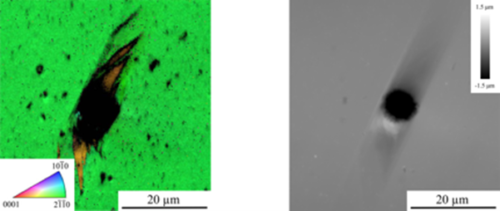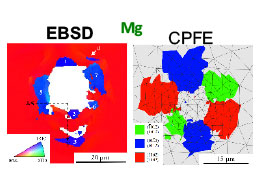Nanoindentation of HCP metals
The overall objective of our research is focused on the characterization of competing deformation mechanisms in magnesium (Mg) by micromechanical experimentation and simulation. In particular, single crystal nanoindentation is extensively used for this purpose. Electron backscatter diffraction (EBSD) and atomic force microscope (AFM) are employed to fully characterize the microstructure and residual deformation around the indents (Fig. 1). Based on this data, new analysis procedures have been developed to extract information about the active slip and twinning systems. Special attention has been placed on the study of the sharp anisotropic mechanical behaviour of Mg depending on the orientation of the indented plane. In addition, the previous methodology has been extended to study the effect of temperature on the deformation mechanisms of this material carrying out nanoindentation tests at temperatures up to 250ºC.

Indentation performed in a prismatic grain at RT: (a) EBSD inverse pole figure map in a direction parallel to the indentation axis; (b) AFM topography.
The experimental procedure introduced before is coupled with in-house developed simulation tools. Crystal plasticity finite element (CPFE) simulations are performed in order to reproduce the indentation processes (Fig. 2). Pre-processing scripts have been developed to generate 3D finite element indentation models. The constitutive parameters of the CPFE models are calibrated based on the experimental deformation patterns found near the indents, using the load-displacement curve of the indentation process also as an important input. To facilitate this fitting procedure, the post-processing of the experimental and simulation data is automated using python scripting.
Future research lines include expanding the current methodology to other metals (zirconium, titanium alloys, etc.) and to other micromechanical testing techniques (micropillar compression). In addition, a nonlinear optimization procedure will be implemented to calibrate the constitutive parameters of the CPFE models. Finally, a novel twinning formulation will be included in the current crystal plasticity model.



